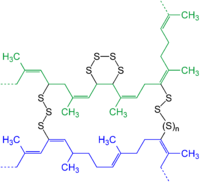
Photo from wikipedia
BackgroundEnzymatic biodegradation of organophosphate pesticides (OPs) is a promising technology to remove these toxic compounds. However, its application in industrial washing was restricted by the lack of efficient immobilized enzymes… Click to show full abstract
BackgroundEnzymatic biodegradation of organophosphate pesticides (OPs) is a promising technology to remove these toxic compounds. However, its application in industrial washing was restricted by the lack of efficient immobilized enzymes that can work at high temperatures and high pHs in the presence of various detergents. Therefore, it is necessary to develop a simple method to prepare a robust immobilized enzyme for efficient degradation of OPs.ResultsAn organophosphate hydrolase (OPH), PoOPHM9, was conjugated and immobilized with a commercially available polymer, Pluronic F127. The prepared cross-linked enzyme-polymer conjugate (CLEPC) displayed higher pH stability in the range from 7.0 to 11.0 and a higher optimal temperature (50 °C) than that of free PoOPHM9 (30 °C). Its half-life and apparent kcat/KM reached 12.8 h at 50 °C and 390.3 ± 7.8 mM−1 s−1, respectively, which were even better than that of the traditional cross-linked enzyme aggregates (CLEA, 7.2 h and 10.9 ± 1.7 mM−1 s−1). The activity of PoOPHM9 CLEPC was further enhanced up to 2.5-fold by the anionic, nonionic and biocompatible detergents, which was first observed. 0.15 mM Malathion was degraded completely by PoOPHM9 CLEPC after activation within 10 min in the presence of 0.1% (w/w) detergents of all types at pH 9.0 and 25 °C, demonstrating its capability in degrading OPs at practically relevant conditions.ConclusionThe conjugation of Pluronic F127 in enzyme immobilization could effectively reduce the activity loss of immobilized enzymes and enhance their stability and activity at high temperatures and high pHs. In addition, the activity of CLEPC can be even enhanced in the presence of various detergents. This technology can be extended easily to produce other immobilized polymer-enzyme conjugates due to its simplicity.
Journal Title: Bioresources and Bioprocessing
Year Published: 2018
Link to full text (if available)
Share on Social Media: Sign Up to like & get
recommendations!